
Federal Reserve Chairmen [1960-2010]
DON’T BE ALARMED! There’s nothing to be seen on this first graph except what an unintelligible mess it is. It’s all the layers of the economic indicators graph I advertised in my last post turned on at once. It’s little wonder that it’s so hard to understand even the basics of our economy. These are just a fraction of the parameters they keep up with to monitor our economic health. Chairman of the Federal Reserve is no job for lightweights:
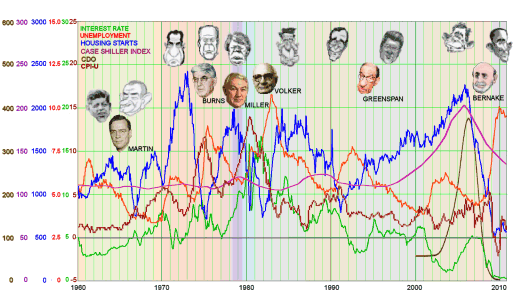
Recall the question, "What’s all that tangle around 1980 about?" So let’s turn on just the parameters that are of interest – Inflation [yr to yr %] and Unemployment [%]:
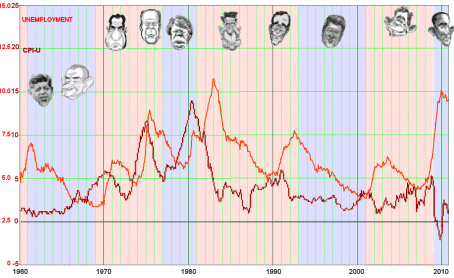
These are the two parameters that people "feel" directly – Inflation and Unemployment. In the former, one’s money loses value quickly and the latter shows on the streets. During the Presidency of LBJ, inflation began to rise. Both Nixon and Ford were able to stem the rise temporarily but it kept bouncing back. High Inflation and unemployment were probably factors in Ford’s and Carter’s defeat in runs for second terms. During Reagan’s Presidency, the Inflation was finally handled, and the relatively big Recession abated. George H. W. Bush ran for his second term during the next Recession and failed to be re-elected. Thereafter, the Clinton and George W. Bush years were surprisingly prosperous, marred only by a "light" Recession. Then, as we know only too well, the bottom fell out towards the end of George W. Bush’s Presidency.
This is how we usually think about economic matters, "who was President?" The truth is that we would be better placed to think about who is in charge of the Federal Reserve, and how did the Chairman respond to the matters at hand. As much as many would like to think otherwise, we have a "regulated" economy, and one of the major regulatory forces is the Federal Reserve itself. So here’s the "back story":
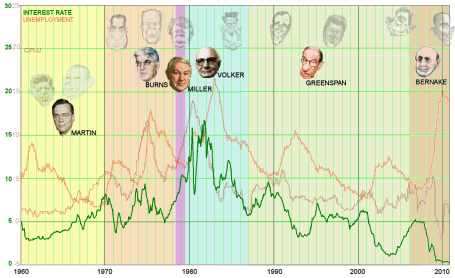
Under Jimmy Carter, Inflation rose precipitously, at least in part due to Nixon/Ford’s unwillingness to deal with it definitively. So, in 1979, Carter appointed Paul Volker as Chairman of the Federal Reserve. Volker immediately set out to curb Inflation ["stagflation"] by raising the Interest Rates to record levels. He was reappointed by Ronald Reagan, and in spite of vocal protests from industry and agriculture, was able to finally quell inflation by radically "tightening" the flow of money.
So much changed during the Reagan Era that it’s hard to parse the contributions of all the different aspects of "Reaganomics" – Income Taxes were slashed, the National Debt soared, and it was the beginning of deregulation – essentially the undoing of the safeguards put in place by F.D.R. as part of the New Deal in the 1930’s. In fact, Paul Volker himself was replaced as Chairman in 1987 because he was not keen on deregulation.
It seems like there wouldn’t be much left to say about Alan Greenspan, but this trip down memory lane brings out a really essential point. Back in the Nixon Era, Nixon actually interfered with the supposedly independent Federal Reserve’s function in our economy. He kept Arthur Burns from raising Interest Rates to stop Inflation in order to garner more votes in the next Presidential election. The consequence was a recurrent Inflation problem until Volker stepped in and did the right thing – raise the Interest Rates. It’s what you do when there’s Inflation. So comes Greenspan who kept Interest Rates low during his entire eighteen year stint as Chairman. When people saw that he wasn’t raising the Interest and asked "why?" he said, "There’s no Inflation." While that was factually accurate, he was breaking Martin’s rule ["the job of the Federal Reserve is ‘to take away the punch bowl just as the party gets going,’ referring to the need to raise interest rates when the economy is at its most active."]. But worse than that, look at this next version of the graph:
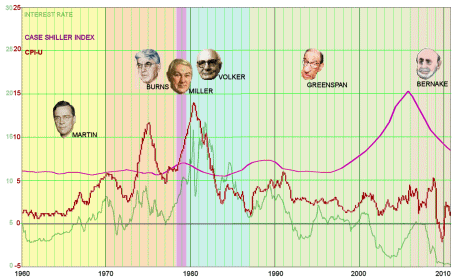
There was, indeed, no INFLATION of our currency, but there was massive Inflation in HOME VALUES! That’s all a ‘bubble is’ – localized inflation! And Greenspan didn’t do anything about it. So during a period of persistent Inflation, he kept the Interest Rates at their lowest levels ever, which further enabled the Housing Bubble. Inflation is Inflation – whether it’s our currency or the value of Real Estate.
So where that leaves us is in the deepest possible hole, with an empty toolbox. Our two main tools to fight Recession/Depression are Federal Reserve Interest Rates and Economic Stimulus. The former is at virtually zero and unavailable. The latter is equally unavailable because the National Debt has been essentially maxed out by Reagan/Bush/Bush.
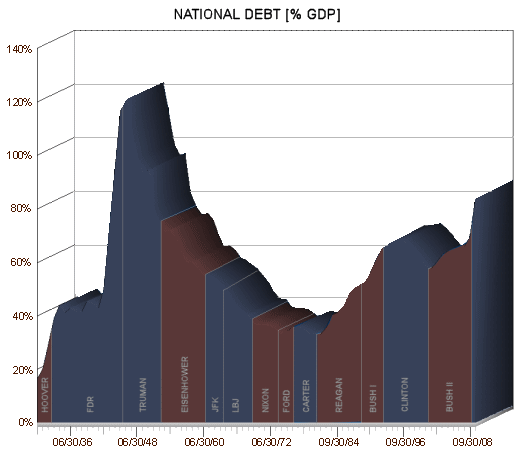
That’s scary.
Wow. This is one of the best run downs on the FED years that I’ve come across. Looks like a pretty big mess.
Print, baby, print. Mo money, mo money, mo money. Bernanke is a criminal
[…] on Wednesday 20 October 2010 Last week I was obsessing about inflation and the CPI-U [Consumer Price Index, Urban]. But then I ran across […]